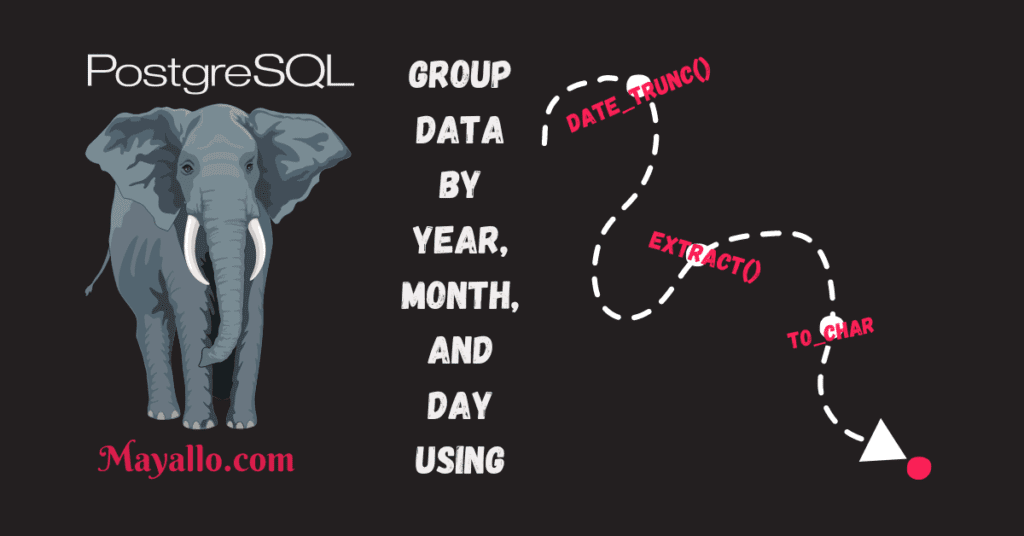PostgreSQL is one of the best relational databases that developers use on a daily basis.
In fact, PostgreSQL supports a wide range of data manipulation and analysis features. One of the most important analysis features is grouping data by a specific interval.
Let’s represent how PostgreSQL handles this feature elegantly.
Before digging deeper, let’s consider that you have the following orders table:
| id | price | createdAt |
|---|---|---|
| 1 | 100 | 2022-01-12 01:15:00 |
| 2 | 120 | 2022-02-10 23:44:00 |
| 3 | 80 | 2023-01-09 08:14:00 |
| 4 | 150 | 2023-07-09 20:50:00 |
| 5 | 50 | 2023-07-10 09:33:00 |
| 6 | 30 | 2023-07-10 15:23:00 |
| 7 | 90 | 2023-09-23 10:12:00 |
And your manager asks you three requirements:
- Calculate the total orders’ sales every year.
- Calculate the total orders’ sales every month in 2023.
- Calculate the total orders’ sales every day in July 2023.
Let’s solve the first requirement.
This function, as its name implies, truncates a date based on a specific date part. You can know more about it here.
SELECT DATE_TRUNC('YEAR', "createdAt") AS year, SUM("price") AS total
FROM "orders"
GROUP BY year
ORDER BY yearThis statement returns:
| year | total |
|---|---|
| 2022-01-01 00:00:00 | 220 |
| 2023-01-01 00:00:00 | 400 |
You might note, that the year field returned as a timestamp rounded to a specified level of precision, not as a number.
To return the year as a number, you can use the following:
SELECT DATE_PART('YEAR', DATE_TRUNC('YEAR', "createdAt")::TIMESTAMP)::INTEGER AS year
...::INTEGER casts the double value returned from DATE_PART() to an integer.
This function extracts a year, month, or … from a date. Know more about it here.
SELECT EXTRACT(YEAR FROM "createdAt")::INTEGER AS year, SUM("price") AS total
FROM "orders"
GROUP BY year
ORDER BY yearThis statement returns:
| year | total |
|---|---|
| 2022 | 220 |
| 2023 | 400 |
Unlike the DATE_TRUNC() function, the EXTRACT() function returns the year as a double. So I used ::INTEGER to cast the double value returned from EXTRACT() to an integer.
This function converts its input to a string. Check it out here.
SELECT TO_CHAR("createdAt", 'YYYY')::INTEGER AS year, SUM("price") AS total
FROM "orders"
GROUP BY year
ORDER BY year::INTEGER casts the string value returned from TO_CHAR() to an integer.
This statement returns the same result as EXTRACT().
Let’s solve the second requirement.
Like grouping by year, you can group by month in a year using the same functions.
SELECT DATE_TRUNC('MONTH', "createdAt") AS month, SUM("price") AS total
FROM "orders"
WHERE DATE_PART('YEAR', "createdAt") = 2023
GROUP BY month
ORDER BY monthThis statement returns:
| month | total |
|---|---|
| 2023-01-01 00:00:00 | 80 |
| 2023-07-01 00:00:00 | 230 |
| 2023-09-01 00:00:00 | 90 |
SELECT EXTRACT(MONTH FROM "createdAt")::INTEGER AS month, SUM("price") AS total
FROM "orders"
WHERE DATE_PART('YEAR', "createdAt") = 2023
GROUP BY month
ORDER BY monthThis statement returns:
| month | total |
|---|---|
| 1 | 80 |
| 7 | 230 |
| 9 | 90 |
SELECT TO_CHAR("createdAt", 'MM')::INTEGER AS month, SUM("price") AS total
FROM "orders"
WHERE DATE_PART('YEAR', "createdAt") = 2023
GROUP BY month
ORDER BY monthThis statement returns the same result as EXTRACT().
Let’s solve the third requirement.
SELECT DATE_TRUNC('DAY', "createdAt") AS day, SUM("price") AS total
FROM "orders"
WHERE DATE_PART('MONTH', "createdAt") = 7 AND DATE_PART('YEAR', "createdAt") = 2023
GROUP BY day
ORDER BY dayThis statement returns:
| day | total |
|---|---|
| 2023-07-09 00:00:00 | 150 |
| 2023-07-10 00:00:00 | 80 |
SELECT EXTRACT(DAY FROM "createdAt")::INTEGER AS day, SUM("price") AS total
FROM "orders"
WHERE DATE_PART('MONTH', "createdAt") = 7 AND DATE_PART('YEAR', "createdAt") = 2023
GROUP BY day
ORDER BY dayThis statement returns:
| day | total |
|---|---|
| 9 | 150 |
| 10 | 80 |
SELECT TO_CHAR("createdAt", 'DD')::INTEGER AS day, SUM("price") AS total
FROM "orders"
WHERE DATE_PART('MONTH', "createdAt") = 7 AND DATE_PART('YEAR', "createdAt") = 2023
GROUP BY day
ORDER BY dayThis statement returns the same result as EXTRACT().
In this article, we knew how to group data by a specific date interval, year, month, and day.
And to do so, we introduced three different ways using:
- DATE_TRUNC()
- EXTRACT()
- TO_CHAR()
If you liked this article please rate and share it to spread the word, really, that encourages me a lot to create more content like this.
If you found this article useful, check out these articles as well:
- MongoDB GridFS Made simple
- Isolation Levels In SQL Server With Examples
- 4 Ways To Handle Asynchronous JavaScript
Thanks a lot for staying with me up till this point. I hope you enjoy reading this article.




